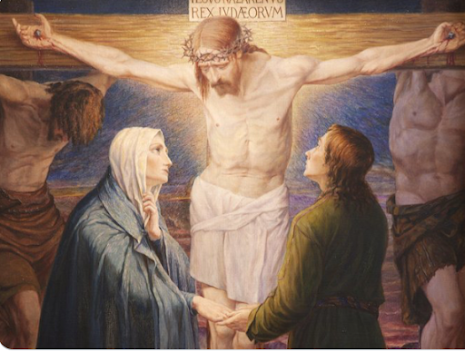Later, during his public life, Mary rarely followed him physically, but she knew at every moment where he was, and the echo of his miracles and his preaching reached her. Sometimes Jesus went to Nazareth, and was then more time with his Mother; most of his disciples already knew her since that wedding in Cana of Galilee1. Except for the miracle of the conversion of water into wine, in which she played such an important part, the Evangelists do not note that she was present at any other miracle. Nor was she present at the moments when the people were overflowing with enthusiasm for her Son. "You will not see her among the palms of Jerusalem, nor - outside of the first fruits of Cana - at the hour of the great miracles.
"But she does not flee from the scorn of Golgotha: there she is, "juxta crucem Jesu"-next to the cross of Jesus, his Mother. "2 She is normally in Nazareth, in perfect union with her Son, pondering in her heart all that was happening; but in the hour of pain and abandonment, there Mary is.
God loved her in a singular and unique way. However, he did not dispense her from the ordeal of Calvary, making her participate in the pain as no one, except her Son, has ever suffered. She could perhaps have withdrawn to the privacy of her home, far from Calvary, in the kindly company of women; "after all, she could do nothing, and her presence did not prevent or alleviate the pains of her Son or his humiliation. And she did not do so for the same reason that a mother remains at the bedside of her dying child instead of going away to distract herself, in view of the fact that she can do nothing to keep him alive or to stop him from suffering. Our Lady was in solidarity with her Son; her love led her to suffer with Him. "3 Little by little she approached the Cross; at the end, the soldiers allowed her to be very close. She looks at Jesus, and her Son looks at her. In a very close union, she offers her Son to God the Father, co-redeeming with Him. In communion with her suffering and dying Son, she endured pain and almost death; "she abdicated her motherly rights over her Son in order to obtain the salvation of men; and to appease divine justice, as far as it depended on her, she immolated her Son, so that it can rightly be said that she redeemed the human race with Christ".
The Virgin not only "accompanied" Jesus, but was actively and intimately united to the sacrifice offered on that first altar. In a voluntary way she participated in the redemption of humanity, consummating her fiat, which years earlier she had pronounced in Nazareth. Therefore, we can think that in every Mass, the center and heart of the Church, we find Mary. On many occasions this reality will help us to live the Eucharistic sacrifice better, uniting to Christ's self-giving our own, which must also be a holocaust, feeling that we are on Calvary, very close to Our Lady.
